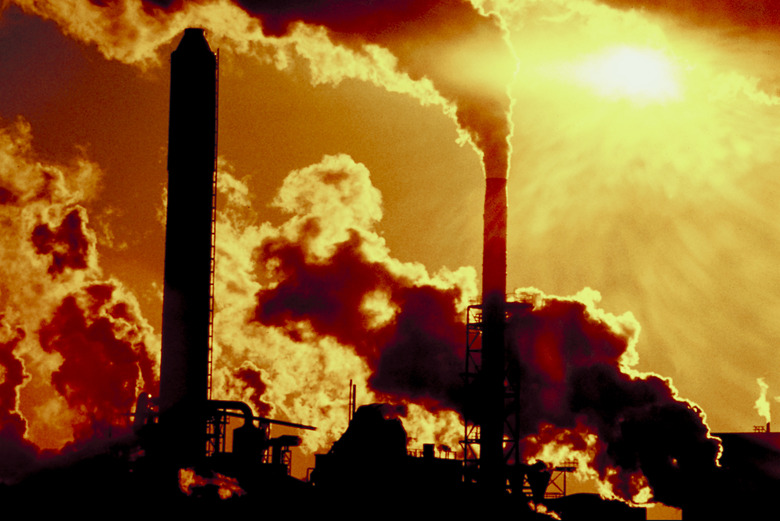Problems That The Earth's Atmosphere Faces
Because the atmosphere is a thin layer when compared to the size of the earth, it faces more severe problems from human activity than other components of the planet. It is a mixture of many gases but its composition is changing. If the changes continue, the problems of the earth's atmosphere may have negative consequences for all life, but particularly for our own complex and energy-intensive civilization.
Greenhouse Gases
The atmosphere is mainly made up of nitrogen and oxygen but contains about 0.04 percent carbon dioxide. This small amount of carbon dioxide lets sunlight pass through the atmosphere but traps the heat produced by the sunlight when it hits the surface of the earth. We produce carbon dioxide when we burn fossil fuels like oil and gas, and the added carbon dioxide increases the amount of trapped heat. The carbon dioxide acts like the glass in a greenhouse, heating up the earth. Carbon dioxide and some other gases that act the same way, such as methane, are called greenhouse gases and help cause global warming.
Other Gases
A second problem the atmosphere faces is contamination from other harmful gases. In addition to carbon dioxide, factories and power plants produce sulfur and nitrogen oxides. These pollutants enter the atmosphere via smokestacks, exhaust fans and evaporation, and the atmosphere distributes them around the globe. When local contamination is severe, it can cause respiratory ailments and aggravate conditions such as asthma and cause acid rain. In the United States, the Environmental Protection Agency has forced industries to reduce the emission of harmful gases but some other countries still pollute extensively.
Ozone Layer
One of the upper layers of the atmosphere, the stratosphere, located from 10 miles to 30 miles high, contains ozone, which absorbs most of the harmful ultra-violet rays from the sun. If all of these rays penetrated the atmosphere and reached the surface of the earth, they would damage plants, cause mutations and give humans skin cancer. Some chemical products, especially refrigerants such as chlorofluorocarbons, can rise into the stratosphere and reduce the amount of ozone by interacting chemically with it. When there is less ozone, more ultraviolet rays penetrate the atmosphere and reach the ground. This problem is less serious now that the use of chlorofluorocarbons in refrigeration and air conditioning is restricted.
Particles
Contamination of the atmosphere with dust and particles is a serious problem, both locally and internationally. Industrial processes and explosions may release harmful particulate matter into the atmosphere, depositing the dust over wide areas and then spreading it around the world when it reaches the upper atmosphere. This is of special concern when winds spread pesticides, radioactivity or other dangerous material. Contamination from pesticides has been found in the arctic and radioactivity from nuclear accidents, such as Chernobyl and Fukushima, spread over large areas.
Cite This Article
MLA
Markgraf, Bert. "Problems That The Earth's Atmosphere Faces" sciencing.com, https://www.sciencing.com/problems-earths-atmosphere-faces-19766/. 24 April 2017.
APA
Markgraf, Bert. (2017, April 24). Problems That The Earth's Atmosphere Faces. sciencing.com. Retrieved from https://www.sciencing.com/problems-earths-atmosphere-faces-19766/
Chicago
Markgraf, Bert. Problems That The Earth's Atmosphere Faces last modified March 24, 2022. https://www.sciencing.com/problems-earths-atmosphere-faces-19766/
